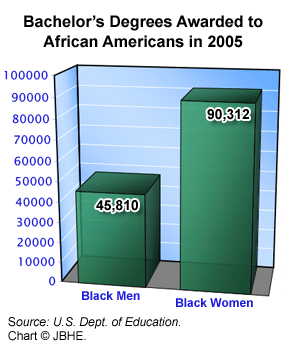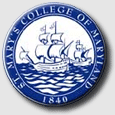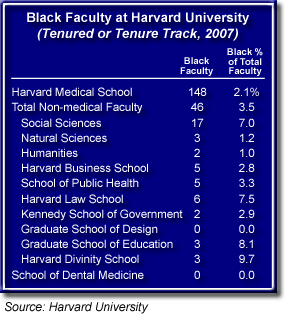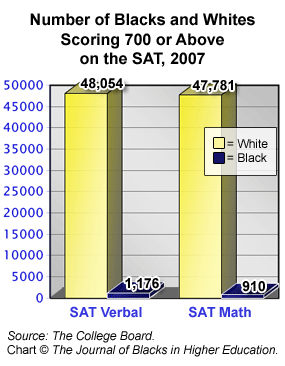Census Study Finds That the Number of Blacks in Prison Is Triple the Number of Blacks Who Live in College Dormitories
The U.S. Census Bureau reports that there are three times as many African Americans housed in prisons as there are blacks who live in college dormitories. The study found that in 2006 there were 846,735 African Americans incarcerated in adult correctional facilities in the United States. But there were only 270,018 African Americans who lived in college dormitories.
For the entire population of the United States, including all races, there were about 250,000 more people living in college dormitories than in prisons. The data does not include so-called commuter students or those who live off-campus.

  |
 If Barack Obama won the Democratic nomination for president of the United States, “every Democrat running on that ticket next year would lose, because he’s black and he’s top of the ticket. We’d lose the House, the Senate, and the governors and everything.” If Barack Obama won the Democratic nomination for president of the United States, “every Democrat running on that ticket next year would lose, because he’s black and he’s top of the ticket. We’d lose the House, the Senate, and the governors and everything.”
— South Carolina state senator Robert Ford, an African American, in his announcement endorsing Hillary Clinton for president
|
The Gender Gap in Bachelor’s Degree Awards to African Americans
In the 2004-05 academic year, black women earned 90,312 bachelor’s degrees, almost double the number earned by black men. Black women now earn two thirds of all bachelor’s degrees obtained by African Americans.
Do not be mistaken. Black men, too, have made progress. Over the past decade, the number of bachelor’s degrees earned by black men is up more than 40 percent. But the result pales in comparison to the huge gains posted by black women.

Hillary Clinton Unveils Her Plan for Higher Education: Substantial Meat for the Middle Class and a Few Bones for Poor Blacks
 Hillary Clinton has geared her entire presidential campaign to attracting voters from the middle class. Even her campaign tour bus is called “The Middle Class Express.” Hillary Clinton has geared her entire presidential campaign to attracting voters from the middle class. Even her campaign tour bus is called “The Middle Class Express.”
In unveiling her new program for higher education, Senator Clinton offers a wide variety of initiatives to make college more affordable for middle-class students including a $3,500 tuition tax credit.
But the Clinton program also offers some proposals of particular interest to African Americans: The Clinton plan calls for:
• Pell Grant awards to be indexed to the rising cost of a college education.
• A $250 million “Graduation Fund” which will be used to launch performance-based efforts to improve graduation rates, especially among low-income and minority students.
• A program aimed at nontraditional college students such as older Americans and working mothers to allow them to attend college less than half-time and still receive federal student aid.
• The most selective schools expanding access for low-income and minority students by spending a greater percentage of their endowment annually on recruiting more low-income students and students of color. Clinton does not offer specifics on what steps she would take to compel colleges and universities to spend more of their endowment income on recruiting minority students.

ST. MARY’S COLLEGE OF MARYLAND

Assistant/Associate Professor
of Creative Writing
English, 18952 E Fisher Rd, St Mary's City, MD 20686 http://www.smcm.edu
Seeking tenure-track professor of Creative Writing, PhD or MFA, to begin August 2008. The successful candidate will join a department in which creative writing and literary analysis are unusually well integrated, with many colleagues who publish and teach in both fields. He or she will be encouraged to participate in the departmental development of creative writing activities, in what is already a vibrant and rich campus writing community. Teaching responsibilities of three classes per semester, among them creative writing at all curricular levels; while we welcome candidates who are themselves poets, novelists, dramatists, or essayists, we would prefer a candidate who can comfortably teach in at least two genres. All faculty share in some way in the teaching of the Core Curriculum, which includes literature and expository writing classes, as well as first-year seminars and independent year-long senior theses.
St. Mary’s College of Maryland is Maryland’s designated public honors college for the liberal arts, and candidates must be committed to providing a liberal arts education within a small college setting. St. Mary’s faculty benefit from a comprehensive program of support for scholarship, research, travel, curriculum development, and sabbaticals for pre-tenure and tenured faculty.
To apply, please submit a cover letter mentioning where you saw this advertisement, curriculum vitae, writing sample of no more than 15 pages, and at least three letters of recommendation to Ruth Feingold, Chair. Applications postmarked by 22 October will receive priority. SMCM is an affirmative action/equal opportunity employer.

Study Calls on the University of California to Do More to Increase Racial Diversity on Campus
 A study group on university diversity appointed by the regents of the University of California issued a report stating that the university needs to do more to attract black and other minority students. The report found that although the number of blacks and Latinos graduating from high schools in California has been increasing, their percentages of the student body at the campuses of the University of California have not kept pace. A study group on university diversity appointed by the regents of the University of California issued a report stating that the university needs to do more to attract black and other minority students. The report found that although the number of blacks and Latinos graduating from high schools in California has been increasing, their percentages of the student body at the campuses of the University of California have not kept pace.
The report recommended that one way for the university to increase racial diversity on its campuses was to make a more pronounced effort to encourage black and other minority students to transfer to the University of California after completing two-year degree programs at California community colleges. The study also recommended that hiring more minority faculty members would help efforts to recruit more minority students.
Black Enrollments Climb at the University of Texas, But There Is Still a Long Way to Go
 The University of Texas at Austin reports a significant increase in black enrollments this fall. There are 2,107 black students on campus this fall. They make up 4.2 percent of the student body. In 2006 blacks were 3.9 percent of all students on campus. The University of Texas at Austin reports a significant increase in black enrollments this fall. There are 2,107 black students on campus this fall. They make up 4.2 percent of the student body. In 2006 blacks were 3.9 percent of all students on campus.
It should be noted that blacks are 11.5 percent of the population in the state of Texas, so blacks remain significantly underrepresented on the flagship Austin campus.
Business Students at Florida A&M University Win National Competition
 Business school students from Florida A&M University in Tallahassee won the National Student Case Competition of the National Black MBA Association. The event, sponsored by Chrysler Corporation, awards $35,000 in scholarships, $15,000 of which goes to students at the winning business school. Each entrant is given a hypothetical business case and is asked to work up solutions to the company’s problems. Students develop a business plan and give an oral presentation to a group of business executives who judge the proposal on presentation and the feasibility of the students’ solutions. Business school students from Florida A&M University in Tallahassee won the National Student Case Competition of the National Black MBA Association. The event, sponsored by Chrysler Corporation, awards $35,000 in scholarships, $15,000 of which goes to students at the winning business school. Each entrant is given a hypothetical business case and is asked to work up solutions to the company’s problems. Students develop a business plan and give an oral presentation to a group of business executives who judge the proposal on presentation and the feasibility of the students’ solutions.
Florida A&M beat out black MBA students from New York University and the University of Chicago, who finished in second and third place, respectively. Students from 27 other business schools also entered the competition.
Are Racial Incidents on Campus on the Rise?
 A recent headline in the Washington Post read, “Colleges See Flare in Racial Incidents.” The newspaper’s editors came to this conclusion because of four events that recently received press attention in the Washington area. These four events were the hanging of a noose at the University of Maryland, the publication of racist cartoons in the student newspaper at the University of Virginia, the kidnapping and writing of racial slurs on the body of a black student on the campus of Gallaudet University, and the demand by a high-ranking black congressman for an investigation of a racial incident at the U.S. Coast Guard Academy. A recent headline in the Washington Post read, “Colleges See Flare in Racial Incidents.” The newspaper’s editors came to this conclusion because of four events that recently received press attention in the Washington area. These four events were the hanging of a noose at the University of Maryland, the publication of racist cartoons in the student newspaper at the University of Virginia, the kidnapping and writing of racial slurs on the body of a black student on the campus of Gallaudet University, and the demand by a high-ranking black congressman for an investigation of a racial incident at the U.S. Coast Guard Academy.
 Last week a noose was found hanging on the door of Madonna G. Constantine, a professor of psychology at Columbia Teachers College in New York City. Professor Constantine, a graduate of Xavier University in New Orleans who holds a Ph.D. from the University of Memphis, is the coauthor of the book Addressing Racism: Facilitating Cultural Competence in Mental Health and Educational Settings. This noose incident appears to be one of several “copy cat” hate crimes that have occurred due to the vast media interest in the Jena-6 case. Last week a noose was found hanging on the door of Madonna G. Constantine, a professor of psychology at Columbia Teachers College in New York City. Professor Constantine, a graduate of Xavier University in New Orleans who holds a Ph.D. from the University of Memphis, is the coauthor of the book Addressing Racism: Facilitating Cultural Competence in Mental Health and Educational Settings. This noose incident appears to be one of several “copy cat” hate crimes that have occurred due to the vast media interest in the Jena-6 case.
But despite what seems to be a rash of racial incidents on campus, the fact is that racial incidents have long plagued the campuses of America’s colleges and universities. Data from JBHE’s sister publication, The Race Relations Reporter, shows that there have been more than 1,300 reported incidents of racial hate on campuses across the United States over the past 15 years. According to the statistics, the number of racial incidents on campus has held steady over the years.

MASSACHUSETTS INSTITUTE OF TECHNOLOGY

Assistant Professor, Design and Manufacturing
The Department of Mechanical Engineering at MIT is looking for a tenure-track Assistant Professor in the area of Design and Manufacturing with an interest in environmental issues.
Three convergent trends will likely change the way in which we design and manufacture products in the future: a vast increase in demand for manufactured goods from a rapidly industrializing global economy, the increasing price of hydrocarbon fuels, and increasing concerns for the environment. New treaties and rules are now falling into place which limit the carbon footprint of a product in its lifetime, mandate recycling by producing companies, and regulate the use of different types of materials. We are seeking an individual who conducts research in design and manufacturing with an interest in the environment – be it designing products in such a way that their carbon footprint is minimized, designing and manufacturing equipment for renewable energy sources, or analyzing and improving manufacturing processes in order to reduce impact on the environment. Our scope is broad, and we invite candidates to describe the implications of their research and approach on the environment.
The candidate must hold an earned doctorate and should have a firm intellectual foundation in one of several possible related fields. These could include a traditional area like mechanics, materials, or design, a particular technology thrust area (we would be particularly interested in equipment and product designs or renewable energy systems) and various analysis tools. In particular, this individual should be able to teach a graduate level course in design or manufacturing.
Applicants should send a curriculum vita, a research statement, a teaching statement, and copies of not more than three publications. They should also arrange for four individuals to submit letters of recommendation on their behalf. This information must be entered electronically at the following site: http://search-meche.mit.edu
Applications received by December 15, 2007 will receive full consideration.
MIT is an equal-opportunity/affirmative action employer. Women and underrepresented minorities are especially encouraged to apply.

Appointments
 • Wole Soyinka, the 1986 Nobel laureate in literature from Nigeria, was named the President’s Marymount Institute Professor in Residence at Loyola Marymount University in Los Angeles. • Wole Soyinka, the 1986 Nobel laureate in literature from Nigeria, was named the President’s Marymount Institute Professor in Residence at Loyola Marymount University in Los Angeles.
• Ronda C. Henry was named professor of English and public scholar in African-American studies and undergraduate research at Indiana University-Purdue University in Indianapolis. She was an assistant professor of English at DePauw University.
 • Talmadge E. King Jr. was named chair of the department of medicine at the University of California at San Francisco. King has been on the medical faculty since 1996, most recently as the Constance B. Wofsy Distinguished Professor. • Talmadge E. King Jr. was named chair of the department of medicine at the University of California at San Francisco. King has been on the medical faculty since 1996, most recently as the Constance B. Wofsy Distinguished Professor.
 • Barrymore Bogues was named Harmon Family Professor of African Studies at Brown University. He was serving as a professor and chair of the department of Africana studies. • Barrymore Bogues was named Harmon Family Professor of African Studies at Brown University. He was serving as a professor and chair of the department of Africana studies.
Professor Bogues earned his Ph.D. in political theory at the University of the West Indies.
Retirement
 • Irvin D. Reid, the first black president of Wayne State University in Detroit, has announced that he will step down at the end of the academic year. Reid, now 66 years old, said that he felt that the time was right for him to retire. Over the past decade, Reid had doubled the on-campus student enrollment and nearly tripled annual fundraising totals. • Irvin D. Reid, the first black president of Wayne State University in Detroit, has announced that he will step down at the end of the academic year. Reid, now 66 years old, said that he felt that the time was right for him to retire. Over the past decade, Reid had doubled the on-campus student enrollment and nearly tripled annual fundraising totals.
Awards
 • Jeanne C. Sinkford, former dean of the Howard University College of Dentistry and current director of the Center for Equity and Diversity at the American Dental Education Association, received the Trailblazer Award from the National Dental Association. The Trailblazer Award has only been given out three times in the 94-year history of the National Dental Association. • Jeanne C. Sinkford, former dean of the Howard University College of Dentistry and current director of the Center for Equity and Diversity at the American Dental Education Association, received the Trailblazer Award from the National Dental Association. The Trailblazer Award has only been given out three times in the 94-year history of the National Dental Association.
Dr. Sinkford is a graduate of Howard University and also earned a dental degree from Howard. She holds a master’s degree and a Ph.D. in physiology from Northwestern University.
 • Cato Laurencin, Lillian T. Pratt Professor and chair of the department of orthopaedic surgery and professor of biomedical and chemical engineering at the University of Virginia, received the inaugural Robert A. Bland Award in Engineering and Applied Science. The award is given by the School of Engineering and Applied Science to honor Robert Bland, the first African-American graduate of the university. • Cato Laurencin, Lillian T. Pratt Professor and chair of the department of orthopaedic surgery and professor of biomedical and chemical engineering at the University of Virginia, received the inaugural Robert A. Bland Award in Engineering and Applied Science. The award is given by the School of Engineering and Applied Science to honor Robert Bland, the first African-American graduate of the university.
 • Romeo Morrisey, program manager for the Center for Homeland Security Training at the University of Tennessee at Knoxville, was inducted into the ROTC Hall of Fame. Morrisey had a 27-year career in the military. He was in the Pentagon when it was attacked on September 11, 2001. • Romeo Morrisey, program manager for the Center for Homeland Security Training at the University of Tennessee at Knoxville, was inducted into the ROTC Hall of Fame. Morrisey had a 27-year career in the military. He was in the Pentagon when it was attacked on September 11, 2001.
Grants
 • Texas Southern University, the historically black educational institution in Houston, received a $235,994 grant from the U.S. Department of Education’s Ronald E. McNair Postbaccalaureate Achievement Program. The program provides academic counseling, financial aid, mentoring, tutoring, and summer internships for minority students who are preparing for doctoral study. • Texas Southern University, the historically black educational institution in Houston, received a $235,994 grant from the U.S. Department of Education’s Ronald E. McNair Postbaccalaureate Achievement Program. The program provides academic counseling, financial aid, mentoring, tutoring, and summer internships for minority students who are preparing for doctoral study.
• Tougaloo College, the historically black educational institution in Mississippi, received a $698,000 grant from the U.S. Department of Justice. The grant will be used to fund a program to prevent violence against women.
• Lafayette College in Easton, Pennsylvania, received a $100,000 grant from the William Randolph Hearst Foundation. The grant will be used to start a scholarship fund for low-income students.
|
Black Faculty at Harvard: A Mixed Record
 We recently reported that Harvard president Drew Faust had pledged to significantly increase black faculty at the university. A report by Evelynn M. Hammonds, senior vice provost for faculty development and diversity at Harvard, shows that President Faust has a lot of work to do. We recently reported that Harvard president Drew Faust had pledged to significantly increase black faculty at the university. A report by Evelynn M. Hammonds, senior vice provost for faculty development and diversity at Harvard, shows that President Faust has a lot of work to do.
Hammonds’ report identifies 46 blacks among the non-medical tenure or tenure-track faculty at Harvard University. They make up 3.5 percent of the total non-medical faculty with tenure or on the tenure track. There are 27 blacks who hold tenure at Harvard. They make up 3.2 percent of all tenured non-medical faculty.
There are some fields at Harvard where blacks are well represented in faculty positions and others where there are no blacks. There are 17 blacks among the 242 tenured or tenure-track faculty in the social sciences. They make up 7 percent of the total social science faculty. A large number of these teach in the department of African and African-American studies. In contrast, there are only three blacks among the 242 faculty in the natural sciences at Harvard. And there are only two blacks among the 208 tenured or tenure-track faculty in the humanities.
There are no black faculty members at the Harvard School of Dental Medicine or the Graduate School of Design.


DENVER SEMINARY

Position in Philosophy
Denver Seminary is seeking candidates for a tenure-track position in Philosophy, to begin August 2008. Rank to be determined in accord with the successful candidate’s qualifications.
The candidate would possess the Ph.D. (or ABD) in philosophy, a record of (or potential for) excellent teaching, a record of (or potential for) scholarly productivity, and a commitment to teamwork and the nurture of students. The ideal candidate would also have competencies in Metaphysics and Epistemology, the History of Philosophy (particularly ancient philosophy), and Christian Apologetics.
Denver Seminary is committed to a holistic approach to theological education and ministry preparation that integrates content, character, and competence. The candidate must fully support the Denver Seminary statement of faith, mission, and vision. Denver Seminary is committed to expanding the racial, ethnic, and gender diversity of its faculty, staff, and student community. Minority candidates and women are especially encouraged to apply.
Send CV, a list of the names and addresses of a least four referees.
Application close date: December 14, 2007.
For more details click here.

Almost No Blacks Among the Top Scorers on the SAT Test
Most students hoping to qualify for admission to any of the nation’s 25 highest-ranked universities and 25 highest-ranked liberal arts colleges need to score at least 700 on each portion of the SAT.
For admission to the very highest ranked, brand-name schools such as Princeton or MIT, most applicants need scores of 750 to be considered for admission. In many cases, black students who win admission to these institutions have mean SAT scores 15 percent or more below the mean for white students who are admitted.
In 2007, 158,536 African Americans took the SAT test. They made up 11 percent of all SAT test takers. But only 910 African-American college-bound students scored 700 or above on the math SAT and only 1,176 scored at least 700 on the verbal SAT. Nationally, more than 89,000 students of all races scored 700 or above on the math SAT and nearly 75,000 students scored 700 or above on the verbal SAT. Thus, in this top-scoring category of all SAT test takers, blacks made up only 1 percent of the students scoring 700 or higher on the math test and only 1.6 percent of the students scoring 700 or higher on the verbal SAT.
If the nation’s leading colleges and universities were to abandon their race-sensitive admissions programs, it is likely that black enrollments would plummet because African Americans make up only 1 or 2 percent of the top-performing group of students who take the SAT college entrance examination.

The Crosstown Rival That Bested Georgetown University in First Enrolling Black Students
 In 1950, Washington, D.C., was a southern city that adhered to the customs of Jim Crow segregation. At that time no African American had ever earned a bachelor’s or graduate degree from Georgetown University, the highly regarded Jesuit institution of higher learning in Washington. In 1950, Washington, D.C., was a southern city that adhered to the customs of Jim Crow segregation. At that time no African American had ever earned a bachelor’s or graduate degree from Georgetown University, the highly regarded Jesuit institution of higher learning in Washington.
But just a few miles up the road in the northwestern corner of the District of Columbia, black students had become fully established at American University, a private institution affiliated with the United Methodist Church. American University admitted its first black students in 1937. In 1945 American University awarded a Ph.D. to an African American. By 1950 there were 258 black undergraduates and 168 black graduate students on the American University campus.
It would be another two years, in 1952, before Georgetown University would graduate its first black student.
  |
49.2% Percentage of all white students who graduated from high school in 1992 and enrolled in any institution of higher education who had earned a bachelor’s degree by 2000.
30.4% Percentage of all black students who graduated from high school in 1992 and enrolled in any institution of higher education who had earned a bachelor’s degree by 2000.
source: U.S. Department of Education
|
92 High School Students Receive the Princeton Prize in Race Relations
 The Princeton Prize in Race Relations, sponsored by the Princeton University Alumni Association, recently was awarded to 92 high school students in 19 cities across the nation. Nineteen first-place prizes — one in each city — were awarded $1,000. Among the winners were students who organized clothing drives for children in Kenya, who produced a film on economic disparities between the races, and who created an African-American studies curriculum for elementary school students. The Princeton Prize in Race Relations, sponsored by the Princeton University Alumni Association, recently was awarded to 92 high school students in 19 cities across the nation. Nineteen first-place prizes — one in each city — were awarded $1,000. Among the winners were students who organized clothing drives for children in Kenya, who produced a film on economic disparities between the races, and who created an African-American studies curriculum for elementary school students.

MASSACHUSETTS INSTITUTE OF TECHNOLOGY

Faculty Position, Energy Science and Technology
The Department of Mechanical Engineering is seeking outstanding candidates for a tenure-track assistant professor position in the field of energy, energy technology and energy systems. The Department is looking for individuals who will contribute to the engineering and engineering science of modern energy conversion systems and processes. Topics of interest include, but are not limited to, carbon capture in power generation, alternative engines, alternative fuel utilization, hybrid power trains, large-scale energy storage and integrated power systems. Energy-related engineering-science topics include, but are not limited to, multi-physics simulation of transport-chemistry interactions, fundamentals of complex multiphase and reactive flows, interfacial processes, energy conversion under extreme conditions and large-scale energy storage. Candidates must have an earned Ph.D. in their field at the time of appointment.
The successful candidate is expected to teach at the undergraduate and graduate levels in Mechanical Engineering courses including energy conversion subjects. The candidate will also be expected to develop an outstanding research program.
Applicants should send a curriculum vita, a research statement, a teaching statement, and copies of not more than three publications. They should also arrange for four individuals to submit letters of recommendation on their behalf. This information must be entered electronically at the following site: http://search-meche.mit.edu
Applications received before December 15 will be given full consideration.
MIT is an equal-opportunity/affirmative action employer. Women and underrepresented minorities are especially encouraged to apply.

No Blacks in the Entering Class at the University of Missouri Medical School
 For the first time in 30 years, there are no blacks in the first-year class at the medical school of the University of Missouri at Columbia. Ninety-six percent of the 100-member entering class identified themselves as white, and there are three Hispanics. A full scholarship, established for minority students in 2004, was given to a student who classified himself as white but with some Mexican heritage. For the first time in 30 years, there are no blacks in the first-year class at the medical school of the University of Missouri at Columbia. Ninety-six percent of the 100-member entering class identified themselves as white, and there are three Hispanics. A full scholarship, established for minority students in 2004, was given to a student who classified himself as white but with some Mexican heritage.
A year ago whites made up 74 percent of the entering students. Blacks make up between 5 and 7 percent of the students in the returning classes at the medical school.
Fifty-seven African Americans sent in applications to the medical school this year. But 27 of those applicants never sent in complete documentation and therefore were not considered. Of the remaining 30 black applicants, only two were granted interviews and one was accepted. This student decided not to enroll.
Admissions officers state that they have a minimum floor for college grade point averages and scores on the Medical College Admission Test. For those applicants who meet these thresholds, race and other personal characteristics can have a positive impact on admissions decisions.
Rutgers Establishes New Program to Increase Racial and Economic Diversity on Its Four Campuses
 Rutgers University, New Jersey’s flagship educational institution, has announced the Rutgers Future Scholars Program in an effort to increase racial and economic diversity on its campuses. Rutgers University, New Jersey’s flagship educational institution, has announced the Rutgers Future Scholars Program in an effort to increase racial and economic diversity on its campuses.
Under the program, the university will identify high-performing eighth-graders in cities where it has campuses: New Brunswick, Newark, Camden, and Piscataway. Newark and Camden school districts in particular have large percentages of black students.
Students selected for the program will be invited to several campus events each year. In addition, they will be able to participate in college preparation workshops and college entrance examination coaching classes. Students can spend one summer during their high school years on campus to introduce them to college life and a variety of academic pursuits.
Most important, these students will receive free tuition and fees if they are admitted to the university and choose to enroll.
In Memoriam
Daniel Collins (1916-2007)
 Daniel Collins, a civil rights pioneer and the first black faculty member at the University of California at San Francisco School of Dentistry, died late last month at a retirement community in northern California. He was 91 years old. Daniel Collins, a civil rights pioneer and the first black faculty member at the University of California at San Francisco School of Dentistry, died late last month at a retirement community in northern California. He was 91 years old.
Dr. Collins was a native of Darlington, South Carolina. His father owned a business in which he used mules to haul tobacco, coal, and cotton. When Collins was 16, his parents borrowed $200 to send him to Paine College in Augusta, Georgia. He graduated from Paine in 1936 and went on to Meharry Medical College where he earned a degree in dentistry.
After graduation from Meharry, Collins and his new wife, who was a dental hygienist, moved to California and set up a private practice. He served on the faculty of the University of San Francisco dental school from 1942 to 1960. He later was a trustee for four different universities.
In addition to his professional career and teaching responsibilities, Collins founded the Bay Area Urban League, a newspaper for African Americans, a counseling center, a church, and a black-owned savings and loan. He also served a six-year term on the State Board of Education.
William Henry Owens Jr. (1921-2007)
W.H. Owens Jr., professor of English and the former director of the speech and drama program at Virginia Union University, died late last month at a nursing home near Richmond, Virginia. He was 86 years old.
Owens was a theater major at Virginia Union University in the early 1940s, starring in numerous productions staged by the VUU Players. After a brief career as a professional actor, he returned to the academic world to earn a master’s degree from Columbia University and a Ph.D. in theater from the University of Denver. He taught first at the State University of New York at Brockport. In 1977 he returned to Virginia Union University as a professor of English. He served for four years as the vice president for academic affairs before taking over the drama program in 1990. He then revived the VUU Players and directed numerous plays put on by the troupe as well as 10 operas.

MASSACHUSETTS INSTITUTE OF TECHNOLOGY

Assistant/Associate Professor,
Computational Mechanics
The Department of Mechanical Engineering seeks an outstanding individual at the rank of Assistant Professor or Associate Professor without tenure, in the area of Computational Mechanics.
Applicants must hold an earned doctorate by the time of appointment in an appropriate field and must have a demonstrated ability to carry out outstanding research; they must also have a strong record of, or promise for, exceptional teaching. Specifically, applicants must be strong in solid mechanics, and must have demonstrated strength to advance the frontiers of research in modeling, computation, and simulation as practiced in engineering and the sciences underpinning engineering. The computational mechanics research should address the development of novel, robust methods of analysis, and probe deeply into multi-scale and multi-physics phenomena in a new or emerging field. Topical areas of interest are broad, and may include the design of new materials for extreme loading conditions, nano-engineering, renewable energy sources, bio-engineering, and the medical sciences.
Applicants should send a curriculum vita, a research statement, a teaching statement, and copies of not more than three publications. They should also arrange for four individuals to submit letters of recommendation on their behalf. This information must be entered electronically at the following site: http://search-meche.mit.edu
Applications received by December 15, 2007, will receive full consideration.
MIT is an equal-opportunity/affirmative action employer. Women and underrepresented minorities are especially encouraged to apply.

|
 .
.